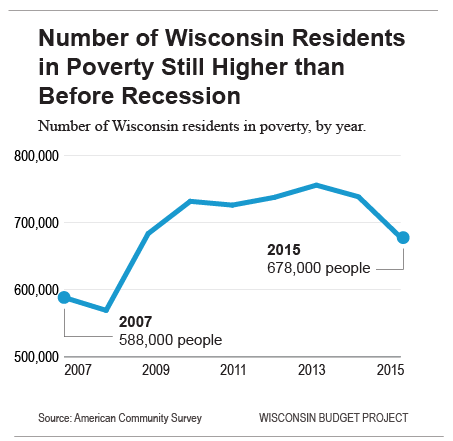Strong Income Gains in 2015, But…
Poverty remains well above pre-recession level, and extreme disparities continue.

Hold the Champagne. Photo from torange.biz.
In many respects, the national and Wisconsin data released by the Census Bureau is much better than I dared hope for, but that doesn’t mean I’ll be popping any champagne corks today. A closer analysis of the data reveals that most Wisconsinites are still making less than they did before the Great Recession, and our state continues to have extreme economic disparities based on race.
Let’s start with some of the very positive news for Wisconsin in the recent Census Bureau data:
- Median household income in Wisconsin grew to $55,638 last year, an inflation-adjusted increase of more than $2,900 in one year. For the country as a whole, median household income rose by $2,100.
- Wisconsin’s overall poverty rate declined to 12.1 percent, which reflects that about 60,000 fewer people were below the poverty line last year, compared to 2014. (The national rate fell even faster, but at 14.7% remains well above Wisconsin’s.)
- Our state’s child poverty rate dropped to 16.4 percent last year, compared to 18.4 percent the previous year.
- The number of Wisconsinites who are uninsured dropped by about 195,000 (more than 37 percent) over the last two years (and nationally there are about 15.5 million fewer uninsured people).
Despite the strong state and national gains in 2015, many challenges remain:
- Median household income in Wisconsin last year was still $2,179 below the inflation-adjusted value in 2007, a drop of 3.8 percent (which is the same as the national decline).
- There were about 678,000 Wisconsinites living in poverty last year, and although that’s significantly below the number in 2014, it’s about 90,000 above the number in 2007, prior to the recession.
- Wisconsin’s child poverty rate is still two percentage points higher than it was in 2007, which reflects about 20,450 more children living in poverty now.
- As the Journal Sentinel reported, Milwaukee had the third highest total poverty rate last year among large cities and the fourth highest child poverty rate.
Wisconsin continues to experience extreme economic disparities based on race and ethnicity, even though the gaps began to close last year. Some examples of those disparities include:
- African American households in the state had a median income of $29,200 in 2015, less than half the $59,100 earned by White non-Hispanic households.
- The 2015 poverty rate was 33.2 percent among Wisconsin residents identifying themselves as Black or African American, and 25.9 percent for Hispanics, compared to 9.0 percent among White non-Hispanic Wisconsinites.
- Wisconsin’s poverty rates among Black children (44.2%) and American Indian children (41.4%) were more than four times the rate for White non-Hispanic children, and the child poverty rate among Hispanic children (32.9%) was more than three times that of White non-Hispanic children.
The new statistics underscore the importance of policy measures to help all Wisconsinites have the opportunity to build a better life for themselves and their kids. Our recommendations include giving businesses access to a well-trained workforce by providing schools and colleges the resources they need to prepare students for employment. We also recommend increasing the minimum wage, reversing cuts to Wisconsin’s Earned Income Tax Credit for low-income working families, and expanding BadgerCare to cover all adults up to 138 percent of the federal poverty level.
Ken Taylor, the executive director of the Wisconsin Council on Children and Families (WCCF), stressed the importance of making policy changes that help families struggling make ends meet:
“No policy maker who claims to care about Wisconsin’s future can justify ignoring poverty or the racial disparities that plague our state. We’re all in this together. If Wisconsin is going to thrive, everyone needs a shot at opportunity.”
Read more in WCCF’s press release, which includes two tables with data for 23 Wisconsin counties, including the trends in income, poverty and health insurance.
Wisconsin Budget
-
Charting The Racial Disparities In State’s Prisons
 Nov 28th, 2021 by Tamarine Cornelius
Nov 28th, 2021 by Tamarine Cornelius
-
State’s $1 Billion Tax Cut Leaves Out 49% of Taxpayers
 Sep 21st, 2021 by Tamarine Cornelius
Sep 21st, 2021 by Tamarine Cornelius
-
TANF Program Serves a Fraction of Poor Families
 Aug 30th, 2021 by Jon Peacock
Aug 30th, 2021 by Jon Peacock





















Let’s not forget, this impressive performance is on top of the fact that most people’s taxes have remained at stable levels or even decreased. That’s a double gain in people’s pocketbooks, and the state pension system remains one of the most well-funded in the entire country.
This is what smart, responsible state budgeting looks like.
“Number of Wisconsin Residents in Poverty Still Higher than Before Recession”
Well, don’t anyone tell John Torinus, he thinks everything is coming up roses …